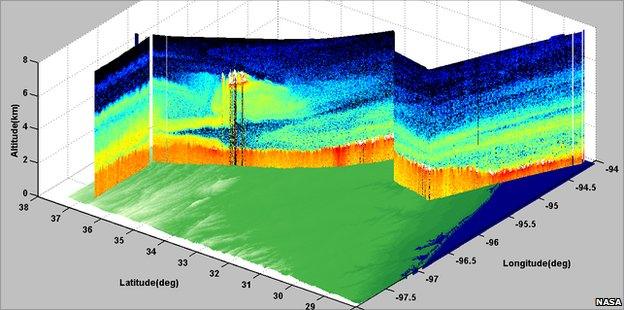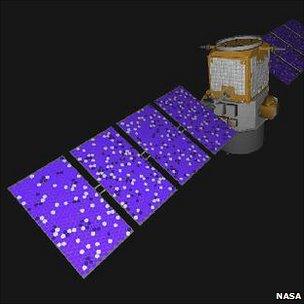More sulphur trails from the stratosphere
- Published
- comments

The Calipso lidar measures backscatter from aerosol particles at different heights in the atmosphere
Tiny aerosol particles in the atmosphere are perhaps the second most important way - after greenhouse gas emissions - in which human activities are changing the Earth's climate.
But changing it how?
The last major Intergovernmental Panel on Climate Change (IPCC) report in 2007 concluded, external that aerosols "remain the dominant uncertainty in radiative forcing" - partially because of the direct effects the particles have, such as reflecting and scattering the Sun's energy, and partly because they can affect cloud formation.
Since that report was compiled, researchers have gone deeper into the known unknowns of aerosols - one of the main aims being to build a picture of how they behave naturally, in order that any man-made perturbation can be more accurately assessed.
The satellite era has made things easier, with instruments on board orbiting platforms such as Calipso, external deploying lidars, external and other instruments capable of sensing how much material is present at what kinds of altitudes.
But still, obtaining a global picture is not easy - and to make things worse, observations have begun in earnest during the very period in which human activities are changing the atmosphere's aerosol load.
But scientific groups are on the case.
A couple of weeks ago, we had some insights into how increased coal-burning - notably from China - could be pumping the stuff into the atmosphere so quickly as to ameliorate the temperature rise from greenhouse gas emissions.

Calipso has brought more accurate and more global measurements of aerosols
Last week, a different research group unveiled new findings, external on the impact of volcanic eruptions, which pump vast amounts of particles into the air, some rising as far as the stratosphere.
The conclusion was that volcanoes may have a greater cooling effect than previously recognised.
And this week, in Science, comes a fresh analysis, external of aerosols in the stratosphere itself, and their impact on global temperatures.
The top line message is that the increase in concentrations over the "noughties" has partially masked temperature rise - similar to the conclusion of the research released two weeks ago, but using a radically different line of inquiry.
And climate models, the researchers say, mostly understate the impact of aerosols in the stratosphere, so may be projecting that temperatures will rise faster than they actually are.
Volcanoes have massive impacts on the stratospheric load of these tiny sulphate particles. But they're fairly short-term, producing stark spikes that decay away after a few years.
But the background aerosol concentration is also changing, the researchers find - for reasons that are not immediately obvious.
When I called one of the researchers, Ells Dutton from the National Oceanic and Atmospheric Administration (Noaa), he described the top line message as "relatively mild".
"When you account for this additional aerosol that's not been accounted for previously, that weakens the overall net forcing that existed over the 2000s.
"So the positive forcing was partially negated by this negative forcing, so you'd expect warming to have been less."

Plumes from tropical volcanoes spread, and enter the stratosphere
But there are also things it doesn't tell us.
The sources could be entirely natural; "but if you then ask whether some of the Chinese stuff is getting into the stratosphere, it could be - we can't sort that out."
Another question is this; if all or most of the sources are natural, what are those sources, besides vulcanism?
So, lots more to research - and one potential implication outside the realm of understanding climate change.
The cheapest of all geo-engineering techniques, external yet conceived involves putting multiple tonnes of this stuff into the stratosphere, where it would reflect sunlight back into space, cooling the Earth's surface.
Controversial, of course; but a number of eminent people such as UK renewable energy pioneer Stephen Salter suggest that research should begin in earnest, because they don't believe our society is going to curb greenhouse gas emissions at anything like the rate needed to slow global warming.

Data on stratospheric aerosols have largely come from studying volcanoes such as Pinatubo
Clearly, if this is ever to be attempted, understanding how the particles will behave in the upper atmosphere would be of paramount importance.
David Keith from the University of Calgary, one of the leading lights in the field, told me this: "I don't see any strong implications for solar geo-engineering, [but] it may help to dispel naive assumptions that solar geo-engineering would be an all or nothing affair.
"In fact, if it ever did make sense to try it, it would make sense to try incremental additions of sulphur coupled with an intense observation campaign that looked for problems."
It's interesting to note by comparison how another geo-engineering option - iron fertilisation of the oceans - has been investigated in practice.
The mass of evidence generated over more than a decade of experimentation has told researchers a lot about the various things that are likely to determine how well it works - and the biggest trial of all, the German Lohafex project, suggested it might not work at all, external.
By comparison, our knowledge about sulphate aerosol injection is tiny.
The title of the Science paper - The Persistently Variable "Background" Stratospheric Aerosol Layer and Global Climate Change - is well-chosen in that it indicates both that significant research has been done, and that the findings it's produced are somewhat frustrating - and honestly given as such.